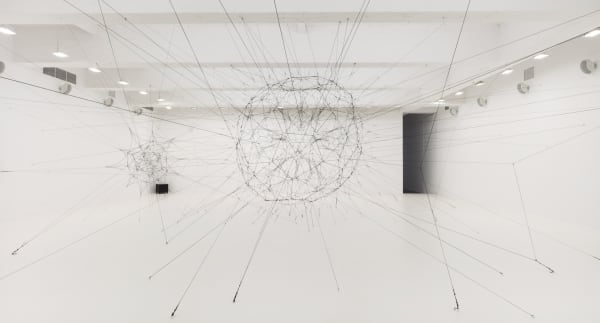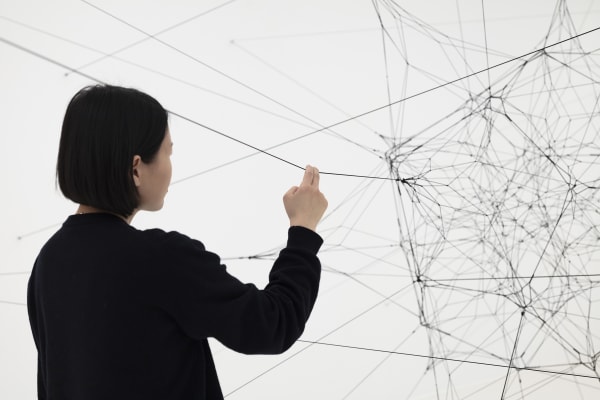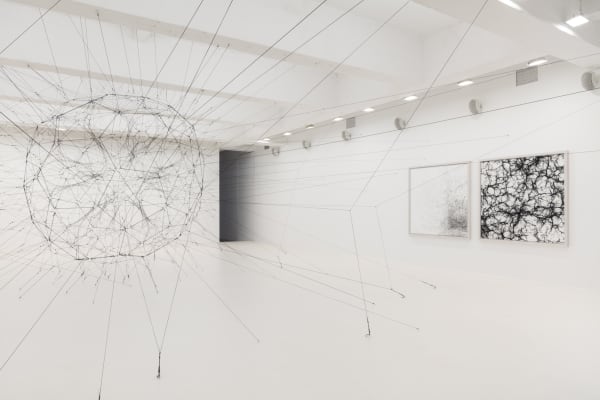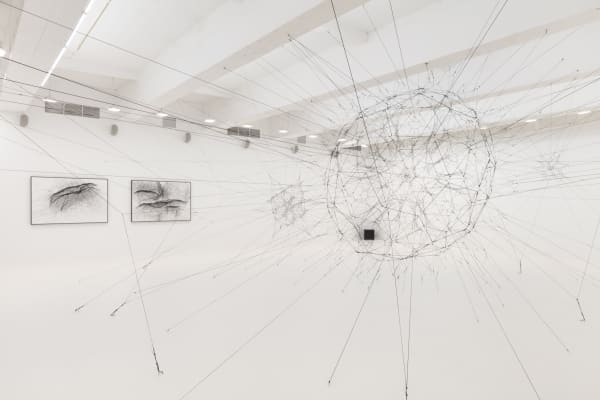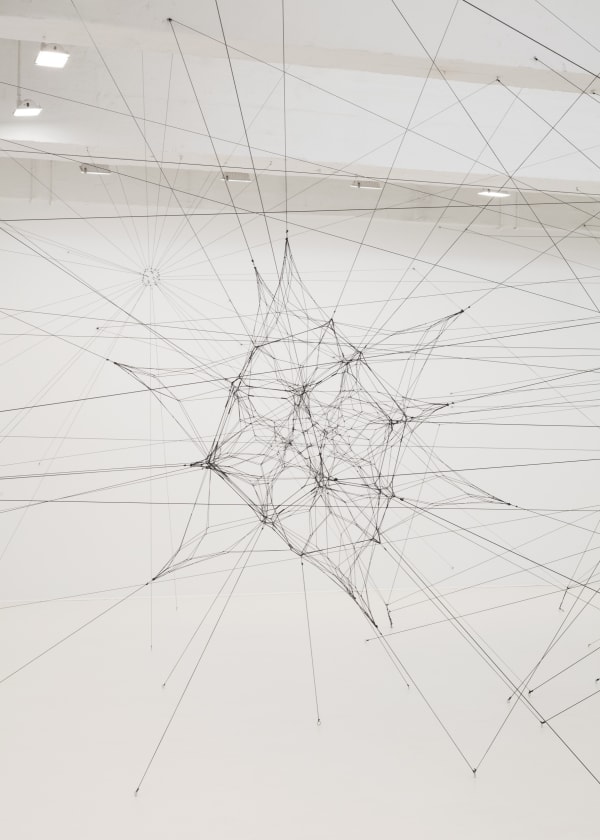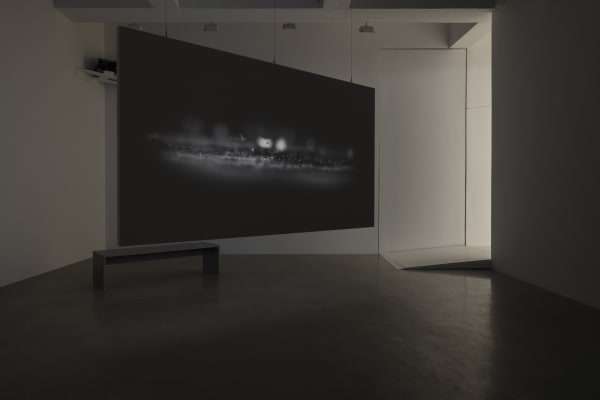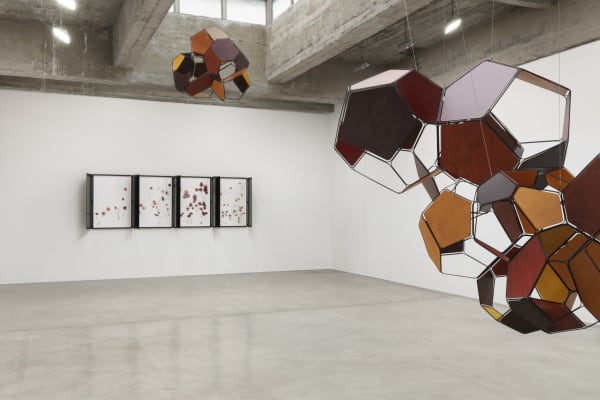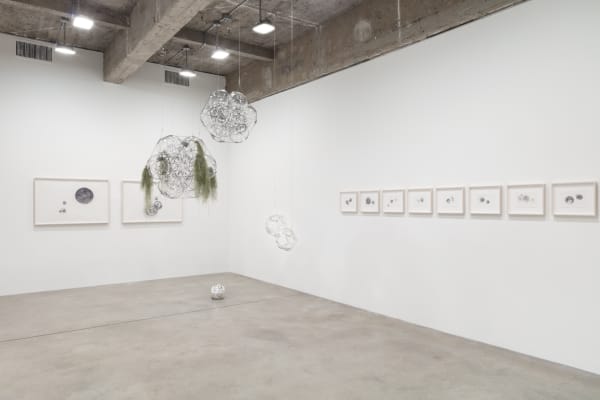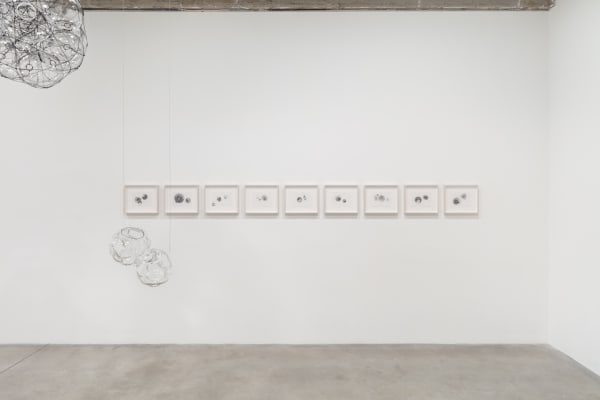Tomás Saraceno: Silent Autumn: Tanya Bonakdar Gallery, New York
Tanya Bonakdar Gallery is pleased to present Silent Autumn, a solo exhibition of new works by Tomás Saraceno on view in New York from February 12 through March 26, 2022. Saraceno invites participants to attune to the intricacies of our entanglement with human, nonhuman and elemental forces. Across a spectrum of perceived realities and through works that connect differently with other beings and phenomena, Saraceno highlights how a considered co-existence encourages new ways of living together, while giving space to existing equitable collaborations with the atmosphere and wider environment.
Visitors arriving to the gallery’s main entrance encounter An Open Letter for Invertebrate Rights, a work emblematic of the artist’s longstanding collaboration with spiders and their webs of life. Underscoring the vitality of preserving situated traditions of knowledge that transcend both human speech and arachnid vibrational language, the proceeds from this letter, as well as spider divination questions asked via Nggamdu.org, will benefit the Mambila people of Somié, Cameroon, a community whose cultural heritage includes the historic, trans-generational ‘nggàm dù’ practice of spider divination. In a time of intersecting global health and environmental crises, this gesture of solidarity with our arachnid kin furthers both inter- and intra-species understanding within this vibrating web of life.
The main gallery features experiential works that evoke the non-verbal communication of spiders to activate vibrational modes of perception, using shifts in scale that alter participants’ understanding of their environment. Algo-r(h)i(y)thms manifests the spiders’ networked web of life as an expansive and intricate musical instrument. Through the act of playing, visitors shape a constantly evolving collaborative musical composition through touching the strings of the web, producing vibrations that echo spiderly modes of communication.
Framing these interrelated installations are Arachne's handwoven Spider/Web Map of Andrómeda, with a duet of Nephila inaurata - four weeks and ensemble of Cyrtophora citricola - three weeks (2022), and Cosmic Filaments, a diptych which brings together an image from the Millennium Simulation - showing the origin of the universe following the Big Bang - and one of a three dimensional reconstruction of a Latrodectus mactans (or black widow) spider/web.* Drawing together both scientific analogies and multi-cultural mythologies, these works speculate on architectural similarities between the universe and silken threads of the spider/web.
In the back room of the gallery, WEBSDR and The Politics Of Solar Rhythms: Cosmic Levitation, both projected video works, explore vibrational phenomena occurring at scales both cosmic and microscopic. WEBSDR is a live haptic painting created from the radio frequencies generated by meteoroids impacting the upper layer of the atmosphere. Here, antennae become the instrument through which a hidden score is written – where space meets Earth, revealing the invisible web of radio waves that envelopes the planet as air molecules are set in motion and rearranged in a new compositional form. The Politics Of Solar Rhythms: Cosmic Levitation, developed as part of an experiment proposed by Tomás Saraceno and conducted with the Jaeger Lab at the University of Chicago, is a collaboration between the controlled sound waves oscillating at a key frequency, where particles of cosmic dust begin to levitate, questioning which worlds might be created at certain rhythms.
The exhibition continues on the second floor with a series of artworks that confront the Capitalocentric perception of nature as an immutable force, as air, water or soil marked by pollution performs as a medium for transformation as well as a narrator of history. Silent Spring features poppy flowers cut from the contaminated soil surrounding the artist’s studio in Berlin-Rummelsburg, a site polluted by the building’s former resident, photographic film and dye manufacturer Actien-Gesellschaft für Anilin-Fabrication (Agfa). Finding lineage from Rachel Carson’s 1962 book Silent Spring, these delicate compositions trace a history of chemical colonization: in Agfa’s attempts to reproduce color pigments of nature, residual chemicals were deposited into the factory’s grounds, contaminating adjacent soils, rendering all fruits of the soil inedible and forever altering the color of its landscape. Framed behind shutters, visitors are invited to observe and re-observe the artwork, hastening the slow fade of the prints with each viewing and exposure in an urgent reminder that, in our attempts to “capture” the color of nature, we change it irrevocably. Now, if humans of the Capitalocene do not shift their methods of “reproducing” nature, that very nature will change—or worse, cease to exist.
The photographic process of exposing light through the medium of film, as well as its tainted history, is refracted in the suite of prints from which the exhibition derives its name. The pressed leaves depicted in Silent Autumn will continue to change throughout the exhibition as their pigment wanes in the gallery’s natural and artificial light. Silent Autumn continues on the adjacent wall, where the same image is photographically reproduced, first digitally, and again using Agfa film stock. Here, the seemingly benign process of photographic capture is investigated, its politics and pollutants exposed in the name of changing our habits and not the climate.
Moving into the adjacent gallery, a series of sculptures connect the consciousness of breath and its physical presence. Here, Saraceno considers both the inequalities of breath in the world but also the myriad languages and traditions in which breath and life are inextricably intertwined. The blown glass works Pneuma, Aeolus, Aeroscale, Aerosolar Serpens encapsulate the spirit of breath, drawing on this powerful life force to reanimate a collective ability to pause and consider essential energies. Many cultures philosophically and linguistically link the concepts of breath and spirit; for Saraceno, this entanglement of breath and spirit filling and forming these glass shapes also helps to construct the question: who has the right to breathe?
Framing the atmosphere’s imperceptible phenomena, the series Calendrier Lun-AIR de Paris features filter paper strips showing hourly variations in levels of particulate matter in the air, collected by Airparif, an organization responsible for monitoring the air quality in the Paris agglomeration. In this work, toxic airborne particles are extracted via Beta Attenuation Monitor (BAM) machines and transposed onto strips of filter paper, creating dots of varying hues that constitute a spectrum of breath and reveals the unequal distribution of particulate matter. Saraceno invites us to reflect on how diversity in air quality and its effects on certain groups has been exacerbated in our pandemic landscape, as air pollution intersects with racial and social injustices. Moving forward from this residue, material and symbolic, will require recognition of the inequities embodied in such an elemental and life-giving substance as air.
The communities most affected by the climate crisis are also the least responsible for it. These communities, located all throughout the world, represent just 5% of the world's population and are custodians for 80% of the planet's biodiversity, which includes the invertebrate species that make up the vast majority of animal life on the planet. In the vibratory umwelt of spiders/webs, the world is an evolving entanglement of senses. Their entangled modes of being, much like the communities who for centuries have attuned themselves variously to their arachnid kin, have been disregarded by the humans of the Capitalocene, and teeter on the edge of extinction.
In the exhibition Silent Autumn, unheard voices become felt vibrations. Nested within a tale of interspecies solidarity, what begins with a call to co-exist empathetically, ends with another to make the means to do so – through the air that we breathe – equal once again. Throughout the exhibition Saraceno reveals how the conditions of our entanglement with nature, and the attempts of those of the Capitalocene to live above it, have conditioned us to an era marked by extractivism, patriarchal capitalism and hyperconsumption. Disrupting these anthropogenic regimes in a re-weaving of our cosmic web, the exhibition mounts a shift towards a living and sensing otherwise; towards sustainable, interspecies cohabitation, from arachnophobia to Arachnophilia. A vibration is felt, not only the invertebrate kind, but a vibration of knowledge across species and cultures that expands a vision for the future.
***
Exhibited concurrently with Silent Autumn at Tanya Bonakdar Gallery is Tomás Saraceno: Particular Matter(s) at The Shed. The artist’s largest exhibition in the US to date, Particular Matter(s) is on view from February 11 to April 17, 2022.
The artist’s work dialogues with other forms of life and life-forming through the ongoing community initiatives Aerocene and Arachnophilia.
*The first Spider/Web Scan, a novel, laser-supported tomographic technique, was developed by Tomás Saraceno with technical contributions from TU Darmstadt, and further developed with MIT.
All installation images above: Photo by Pierre Le Hors
Video by Lance Brewer
A walkthrough video of Tomás Saraceno, 'Silent Autumn' at Tanya Bonakdar Gallery, New York, 2022.
